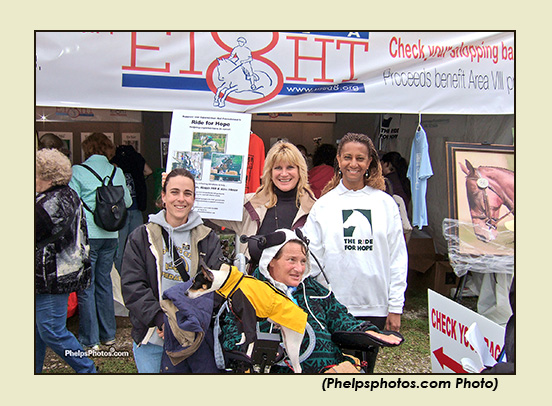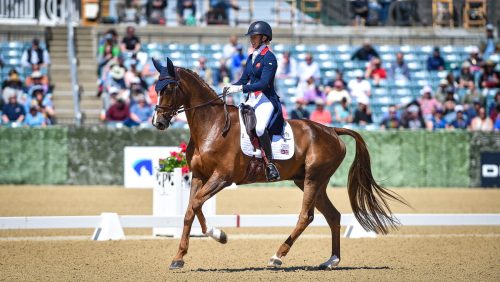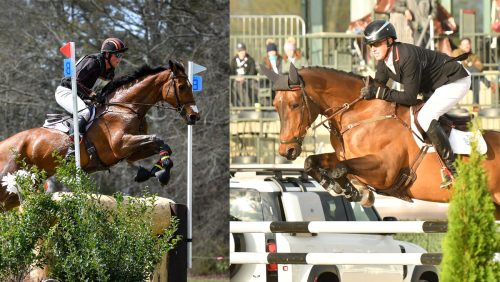
In the wake of multiple high-profile injuries the past year, the eventing community came together to lend a helping hand.
It’s every rider’s nightmare—a sudden, catastrophic injury. It’s a very real risk that all riders weigh when they swing a leg over a horse’s back. And in the past year, for three high-profile event riders, the nightmare came true. Debbie Atkinson, Kim Meier and Ralph Hill all suffered falls that changed their lives forever.
A fall that ends a riding career is tragic no matter what the circumstances, but when it’s a professional rider and trainer, there are significant repercussions. In an instant, their career is brought to a halt. At the very moment they stop being able to earn an income, they begin accumulating massive medical bills.
“I don’t think people realize how many bills there are for different things, even once you’re out of the hospital, and it never stopped. It cost way more than I ever could have imagined or anticipated. It’s an unbelievable amount of money,” said Atkinson of the aftermath of her fall.
Where can these riders turn? Well-meaning family and friends frequently organize fundraising activities to help defray the costs. And the horse community is famous for its generosity, in spirit, deed and funds.
Fundraisers for Atkinson, Meier and Hill have run the gamut, from clinics to trail rides, and dinners with silent auctions to online auctions. All of those efforts have raised much-appreciated and substantial funds.
Perhaps the most successful and high profile of the fundraising efforts was the Area VIII booth at the Rolex Kentucky CCI**** this spring (see sidebar). Volunteers sold shirts, bracelets and posters, with all of the proceeds going to benefit Atkinson, Meier and Hill.
Seeing the funds pour in warmed not only the checkbooks, but also the hearts of those involved. “Riders tend to help one another. And people really want to help, but sometimes they just don’t know how,” said Ruthie Harbison, who oversaw a successful online auction this spring to benefit Meier.
Every little bit helps, as the saying goes, and that’s never so true as in fundraising.
“I’ve always thought about any fundraising, that it’s not about the one big check—it’s about a lot of little checks. And the guy who only has $5 to give should not be embarrassed to give that $5, because every time you put something in, it helps. If everyone gave $5, that would add up to a lot of money,” said upper-level event rider Darren Chiacchia.
A Lot Of Work
In the past, those fundraising efforts usually ended up in bank accounts.
“Whenever someone falls on hard times, people set up funds and reach out, but that’s a lot of work. People might give, but they might be conservative without being fully aware of where the funds are going, or whether they’re tax-deductible,” said Chiacchia.
And, soliciting help, even for a good cause, isn’t for the faint of heart. “It’s a full-time job to raise money for people, if you want to do it effectively, and the right way,” said Harbison.
The American Horse Trials Foundation is a 501c3 organization that allows riders to funnel funds for their riding careers through a tax-deductible path, but the AHTF is focused on helping to further a rider’s career. Until recently, there was no central, organized 501c3 to specifically help with an injured rider’s financial needs.
Enter the Equestrian Aid Foundation. Founded in 1996, the EAF originally was the Equestrian AIDS Foundation, an organization dedicated to providing financial assistance to equestrians with HIV and AIDS. But in 2006, the EAF Board of Directors decided to broaden the foundation’s mission.
Now, the EAF seeks to assist any equestrian. “We’ve always helped riders from all disciplines, and we help anyone, not just elite riders. We help judges, stewards, show secretaries, adult amateurs. We help a very diverse group of people,” said Janise Gray, the EAF director of grant recipient services.
“We do fundraisers, and now we’re working hard to become membership-driven. If you’re an equestrian, and you have a catastrophic injury, that makes you eligible. We can help with medical insurance premiums, medical costs such as physical therapy, medication, nursing help, and we can help defray the costs of your living expenses.
“Obviously, we can’t pay everything. There are state and federal and local organizations that have programs as well,” she added. “We want to be able to assist and give people as much dignity and quality of life as possible during these difficult periods in their life, whether it’s a short period of time or for the rest of their lives.”
More Resources
Chiacchia is now on the EAF Board of Governors. “The EAF is there to help those in the equine industry who have found themselves in the situation of needing some assistance. Quite unfortunately, the eventing community has called upon this assistance more than ever recently. The eventing community wasn’t even really aware of the EAF’s existence. I wanted to help promote the EAF to the eventing community and bring attention to the fact that we really need to support this group,” he said.
ADVERTISEMENT
In fact, it was around the time of Meier’s injury in January that the EAF began to really step forward and make themselves known to eventers. The organization has a long history and throws multiple fundraisers
year-round. With the Area VIII fundraising booth at Rolex, the EAF stepped into the eventing spotlight.
“It’s been an eye-opener for us,” said Gray. “We had helped a couple of people who had been in situations where they needed help for a short time, but then we got Debbie, Kim and Ralph, one right after another. Before, we kept everything anonymous, but these are people who have been in the news and the spotlight. And the things they need are huge—they all have insurance, but insurance doesn’t cover a lot of things.”
Harbison said that when Atkinson and Meier got hurt, there wasn’t really anything central set up that eventers knew about. “But now the effort really seems to have kicked off, with the EAF,” she said. “Now, it’s in motion, and if there’s a serious injury that happens to someone, they have more resources to draw from. It’s not just their friends, pounding the pavement and knocking on doors.”
Atkinson has been touched beyond words by the generosity shown by fellow equestrians.
“I think probably the most amazing thing has been the people that I don’t know, who have never met me, who came forward to help,” she said. “Some people have remained anonymous, and I don’t know who they are, and they actually have given quite a bit of money.”
All of those funds go to a good purpose. “[The donated money has] been very helpful with medical bills that insurance won’t pay for. I have in-home help, and it’s helped pay for that. And we bought a van, and it’s helped pay that off a bit,” Atkinson said.
Prepare Yourself
Fund-raising after a fall should be supplemental to the steps you take to prepare yourself for such an eventuality. No one wants to think about the possibility of a catastrophic injury, but it’s essential to prepare and protect yourself as much as possible.
Health insurance isn’t just a highly charged political issue; it’s a very real necessity for those participating in a high-risk sport such as riding.
Amateur riders might be lucky enough to be covered by their employer’s comprehensive group plan, but most professional riders have to find an individual insurance coverage program that’s affordable, yet as inclusive as possible.
“Getting some expert advice on insurance is essential,” said Chiacchia “You have to know what questions to ask. Is a helicopter ride covered by your policy? Guess what—for most people, that’s a big fat no. What happens when you need home care? That’s not usually covered. Someone decides when your money runs out for any kind of rehab you need, and from that point on, you’re dependent on your own cash reserves.”
The U.S. Equestrian Federation does have a personal accident insurance policy for its members, through the Equisure insurance company and underwritten by Lloyd’s of London. USEF members are covered by the policy for death or permanent disability resulting from a horse-related accident anywhere in the world, whether in competition at a USEF competition or not.
Insurance premiums are included in USEF member dues. The benefits are: $20,000 for death as a result of equestrian-related injury; $30,000 for death occurring at the site of a USEF-recognized event; $35,000 for
permanent total disablement as a result of an equestrian-related injury. The personal accident insurance pays in addition to any personal life insurance policy the member may have.
Most professional riders file for taxes as self-employed, and they frequently use the loss shown on farm expenses against their income to lower their yearly personal income. But that strategy can backfire.
“For supplemental social security income, you get social security based on your earnings. Most horse people don’t pay much into social security because they write off their farm losses against any income they might have. When you do that, it comes back to haunt you in this circumstance,” said Anne Ogletree, an attorney who has helped guide Meier through the maze of paperwork involved in applying for state and federal aid.
“If you wipe out a lot of your earned income with farm losses, you don’t qualify for disability benefits. If you work a normal 9-to-5 job, it isn’t a problem because you pay into social security off your income,” she added. “If you’re self-employed, it’s a balancing act.”
When a career-ending fall happens, it’s a catastrophic event.
“Are there ways of planning for a catastrophic event? Yes, there are some things that you can do to lessen the bite,” continued Ogletree. “You can set money up in programs like the American Horse Trials Foundation, to ensure that your horses are taken care of. But as far as your own personal savings, such as for retirement, it’s going to wipe out all of your assets.”
Area VIII Steps Up
One of the most successful fundraising activities for Atkinson, Meier and Hill was the booth that the U.S. Eventing Association’s Area VIII members set up and manned at the Rolex Kentucky CCI**** in April.
Mike Winter, an amateur event rider from Area VIII, led the organizational effort.
“It started innocently enough, since we were fortunate enough to have some space at the trade fair at Rolex,” he said. “It became obvious that there wasn’t an organized effort for fundraising for Debbie, Kim and Ralph at Rolex, so we ended up in conversations with friends and acquaintances of all three riders about how to establish a presence.
“We put together a group of volunteers to man things, and we handed out flyers at the gate and around the event to publicize it,” he added. “Along the way, a lot of people contributed things—wristbands, posters, money that we used to create T-shirts that we sold. An artist contributed a painting that we auctioned off. Things just started coming out of the woodwork, and the whole thing snowballed. We just tried to create an awareness and an access point for the giving.”
ADVERTISEMENT
The Area VIII booth generated a significant number of contributions, which went to each riders’ preferred 501c3 organization—the EAF and—for Meier—the Maryland Network for Injured Equestrians.
“This gave everyone a channel for that positive energy. You want to figure out how to do something, how to help, and an activity like this helps that process and helps everybody feel like they were able to do something,” Winter said. “There were plenty of cases when people would come up and give $20 or $30, and they didn’t want anything, no wristband or T-shirt. All they wanted to do was help.”
Not Just For Me
Before Kim Meier discovered the Equestrian Aid Foundation, she began using a small 501c3 organization, the Maryland Network for Injured Equestrians. As a long-time resident of Maryland, it made sense for Meier.
MNIE was started in 2005 by Fred Masterman—whose daughter, Peggy Ingles, had suffered a spinal injury in a fall from a horse in September 2004—and Ingles’ friends. The organization hosts an annual fundraiser and reaches out to Maryland equestrians in need.
“When my friends decided to have a fundraiser for me right after my fall, it was unbelievably successful,” Ingles said. “After that, they were talking about planning the next one, and I said, ‘Look guys, I don’t want another one just for me. Let’s do it so that it will benefit a bunch of people. There must be other people in this situation.’
“They picked it up and ran with it and put together the non-profit,” she added. “They’re amazing people, but you know how horse people are.”
Ingles had been a single mother and a successful rider and trainer on the Arabian show circuit. After the fall, she was rendered a quadriplegic.
“My first two weeks in shock trauma cost $1.75 million, not even counting the surgery or the flight there,” she said.
Ingles had to disperse her horses and close her business. She now lives in an apartment in Towson, Md.
Three years later, and with hours of grueling physical therapy under her belt, she’s regained some motion in her arms and walks with the help of therapeutic equipment in her outpatient therapy sessions. She also rides with a local therapeutic riding program.
“When people know someone who has been affected, then it’s easy to raise money to help. You get a big rally of support when it’s someone they know, or know of. And that support especially comes in the acute stage. Trying to keep the energy level and interest up is kind of hard. You have to come up with new ways of attracting attention and getting people to feel strongly about it,” Ingles said.
Updates On The Riders
Debbie Atkinson
Atkinson sustained severe neck and spinal injuries in a fall on cross-country while competing at the Kentucky Classic Horse Trials on Sept. 2, 2006. After her initial hospitalization, she spent two months at the Shepherd Center in Atlanta, Ga., in rehabilitation, and then in January was released and went home to her farm in Columbia, Ky. She was thrilled to be able to attend the 2007 Rolex Kentucky CCI**** as a spectator.
Atkinson is currently quadriplegic but has learned how to maneuver a powered wheelchair. “I think I’m a lot better mentally and emotionally, accepting everything,” she said. “I went to Rolex and other horse trials in Kentucky, to visit students and friends and watch. That was great.
“I have two of my old retired horses here at the farm, and that’s wonderful having horses here again,” she added. “I’ve gone to visit Cathy Wieschhoff, who has my horse Pantera [and is competing her], which was great. I’ve learned how to use the computer somewhat, so I can stay in touch with people.
“I haven’t regained any motion, but I can work the power chair pretty well, and I’m going back to the Shepherd Center in July to get a diaphragmatic pacer, which should get me off the ventilator for 12 hours a day, and maybe I can get back to doing a little bit of teaching. That way I can hopefully be useful,” she noted.
For updates on Atkinson, see www.usea3.org/Debbie-Atkinson/index.html.
Kim Meier
Meier, who was 10th at the 2004 Rolex Kentucky CCI**** on her homebred Test Run, fell while schooling over fences in Altoona, Fla., on Jan. 16, 2007. She suffered damage to the C3 and C4 vertebrae and was paralyzed from the shoulders down.
After a month in the hospital in Florida, Meier was transferred to the Kessler Institute for Rehabilitation in West Orange, N.J. She spent 31⁄2 months there and is now in a nursing home in Centreville, Md., close to her farm.
Meier has regained limited movement in her arms, with her left arm much stronger. She also reports sensation in her left foot and can exert some downward pressure with her left foot.
“I can now feel my toes wiggle. It’s one of those bloody internal things that are invisible to everyone else, but that I can feel,” Meier said. “What is for sure is that I can push my left foot down as if I’m pushing a pedal. That’s visible, and I can make pressure on peoples’ hands that they feel. I do it using my calf muscle and the extensor running over my shin.”
She’s working on learning to drive a hand-controlled power wheelchair and looks forward to continuing outpatient rehabilitation sessions. She hopes to be released from the nursing home as soon as appropriate living arrangements can be made for her. Updates on Meier can be found at www.carepages.com, under her name, KimMeier.
Ralph Hill
Popular advanced-level rider Ralph Hill fell on cross-country at the Poplar Place Horse Trials (Ga.) on March 24, 2007. He suffered a broken femur, humerus and wrist, and a brain stem injury. After his hospital stay, Hill spent a month at a rehabilitation facility in Lexington, Ky., and then was released to stay with family in Kentucky.
Hill is able to converse but has problems with long-term memory. He’s undergoing outpatient rehabilitation for his mental and physical issues. Updates on Hill’s condition can be found at www.carepages.com, under his name, RalphHill.
Molly Sorge














